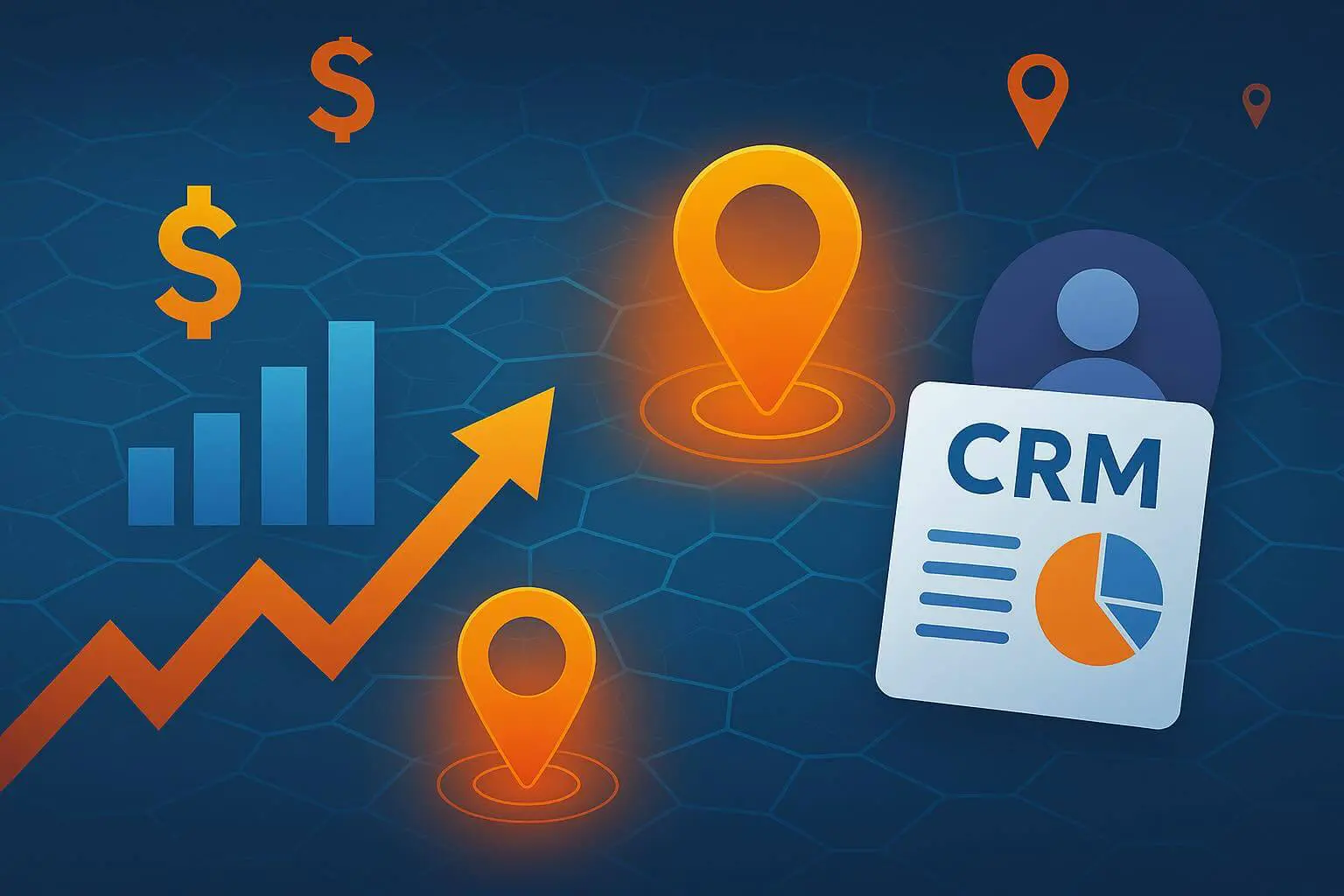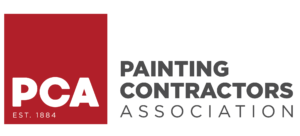
The 3 Main Features of a Local Google Search Result & How to Rank for Them
Businesses know just how crucial every marketing aspect is, and with the rise of the local web, a strong presence in local Google search results is now necessary.
The power of a local Google search is undeniable, but not all businesses know how to maximize it. Some even have yet to learn what it is!
Understanding how search engine optimization (SEO), search engine results pages (SERPs), and other factors all come together can be too much for small and big marketing teams alike.
However, when you master the basics, you can unlock Google’s potential and ensure your business stands out.
Let’s explore vital marketing terms together and break down the three main features of local Google search results.
What Are SERPs?
A search engine results page (SERP) is the page a user views after entering a query into a search engine. It contains the results of a potential customer’s inquiry, presented in an organized list.
For example, when a user searches “roofing services” in Google or any search engine, they’ll see a list of businesses that can help them with their roofing needs. The highest-ranking search results will either be the most relevant or those companies that have paid for them.
That said, search engine optimization (SEO) plays a significant role in SERPs. SEO affects how high your business appears when someone searches for a related product or service.
According to HubSpot, more than 50% of marketers consider keyword rankings and organic traffic the top ways to measure the success of SEO strategies.
As said by seoClarity, out of Google’s 810 unique SERP features, 161 are found on more than 0.2% of keywords.
SerpWatch said that over two-thirds of all clicks on SERPs go to the top five results. So, the higher your ranking, the better your chances of attracting new customers.
However, ranking high doesn’t happen overnight, so businesses should focus on the factors influencing SERPs.
Above all, all efforts should be directed toward reaching the right customers at the right time.
Why Are These Local SERP Features Important?
“Why can’t I just focus on organic SERPs?” you may ask. The answer is simple — it’s not enough.
With the rise of mobile devices and voice search, it has become increasingly important to have a local SEO strategy. Users are now more likely to search for businesses in their vicinity, so you want to ensure your business is visible and accessible.
Using local SERP features to their full potential can help you rank higher for relevant searches, increase visibility, and generate more leads. Optimizing for local SERP features allows you to be discovered by potential customers, allowing them to learn about your business and connect with you.
Still not convinced? Here are some additional reasons:
93% of consumers find a local business through online searches. There are more than 8.5 billion daily Google searches, so a local SEO strategy is essential to increasing your online presence.
42% of local searches involve Google Map Pack clicks. By optimizing for local SERP features, you can make sure your business is visible and accessible on Google Maps.
Mastering the local SERP features is the best way to get ahead of your competition. It’s all about being in the right place at the right time — and local SERP features can help you do that.
How Does Google Identify a Local Search?
Since Google is the top search engine, we’ll focus on it. Google uses different algorithms for local and organic SERP listings. The Google local algorithm focuses on proximity, prominence, and relevance.
Here are three ways the search engine identifies if the search is local:
- The user includes the name of the desired geographic area within their search term.
- The user uses “near me” in their search.
- The user types a search query without additional information.
An example of the first identifier is “restaurants in Miami.” Including a city, town, or neighborhood in the search query will trigger Google to show results within the specified area.
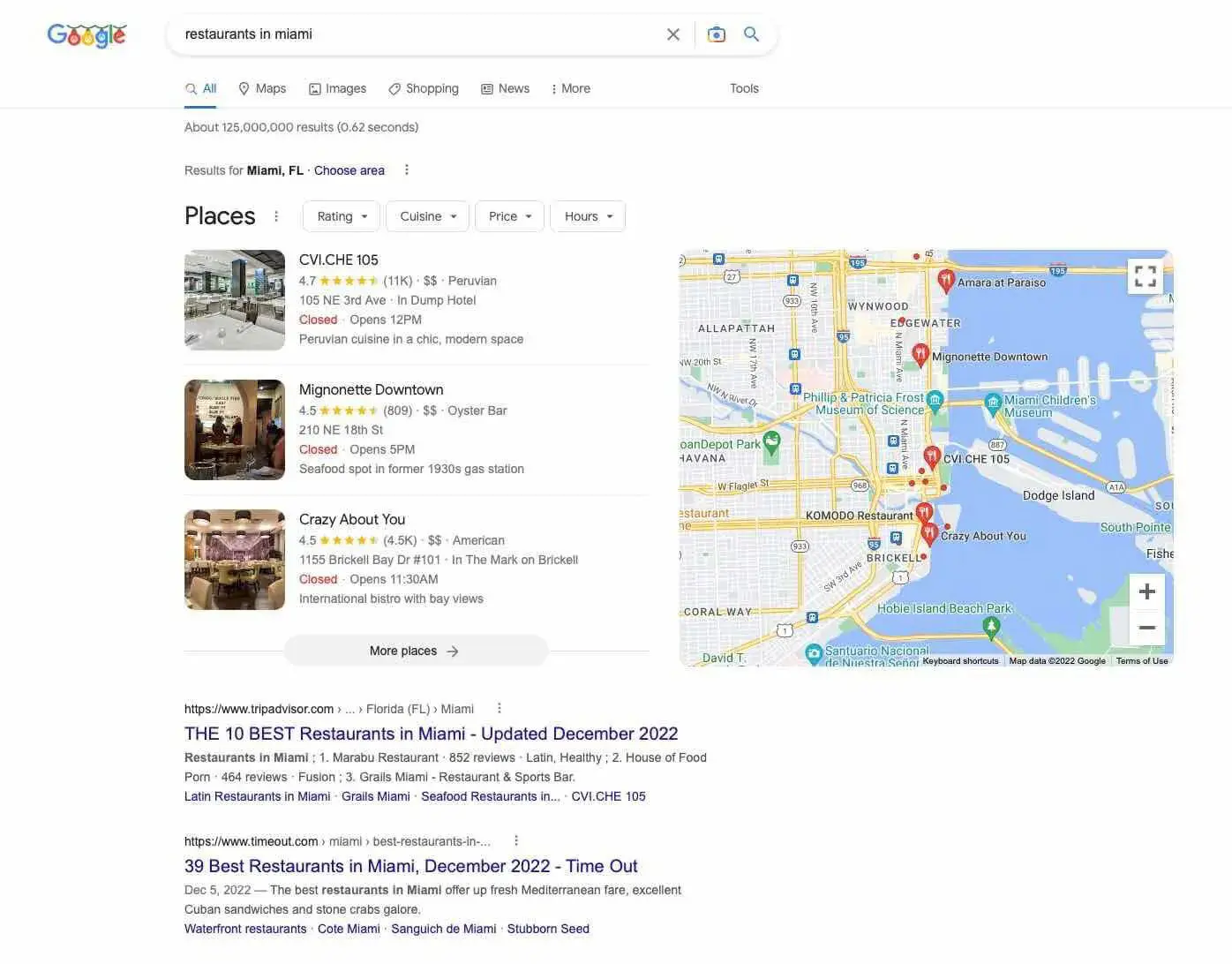
The second identifier could be “restaurants near me,” which will prompt Google to show restaurants closest to the user’s current location. The user must enable the location on their device for this search to work.
Finally, the third identifier is slightly more complex. For example, the user may search “massage spa” without providing additional information. In this case, Google will automatically detect the user’s location and show results relative to it.
The 3 Main Local Google Search Features
You guessed it — ranking highly in local Google SERPs also requires understanding the algorithms behind them. If ranking for organic SERPs is like a game of chess, ranking for local SERPs requires memorizing a book of rules.
However, like ranking for organic searches, it’s also possible to understand the main features Google uses to rank local businesses.
You have various methods to optimize your website for local searches, including:
#1 – Paid Ads
Setting up a Google Ads account allows you to create ads in local SERPs. This feature is likely the riskiest but also the most rewarding.
“Risky” because, with Google Ads, you must pay for each click on your ad. So if no one clicks it, you won’t get any ROI.
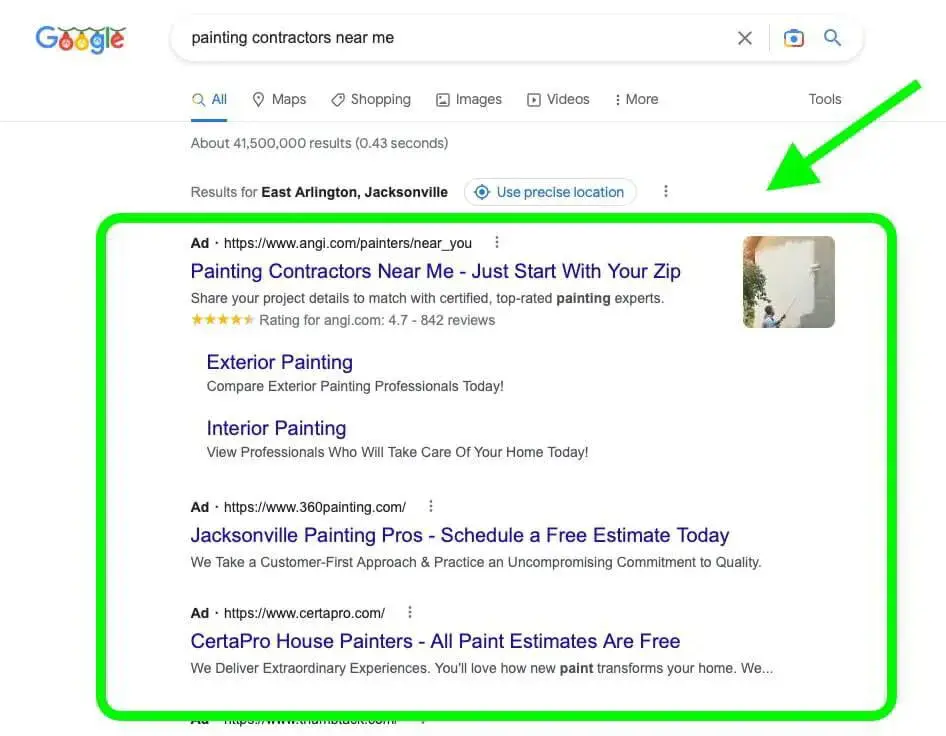
However, you can reap great rewards if you target the right keywords, optimize your ad copy and design, and use effective bidding strategies.
You can create dynamic ads specifically tailored to local searches, allowing you to target users searching for what your business offers.
#2 – Local SEO
SEO is the process of optimizing your website content to improve its visibility in search engine results. You must target relevant keywords for local SEO and create content around them.
Businesses should also optimize websites for the local area, including listing businesses on their Google Business Profile and local directories. This feature will help users find your business quickly and increase the chances of appearing in local SERPs.
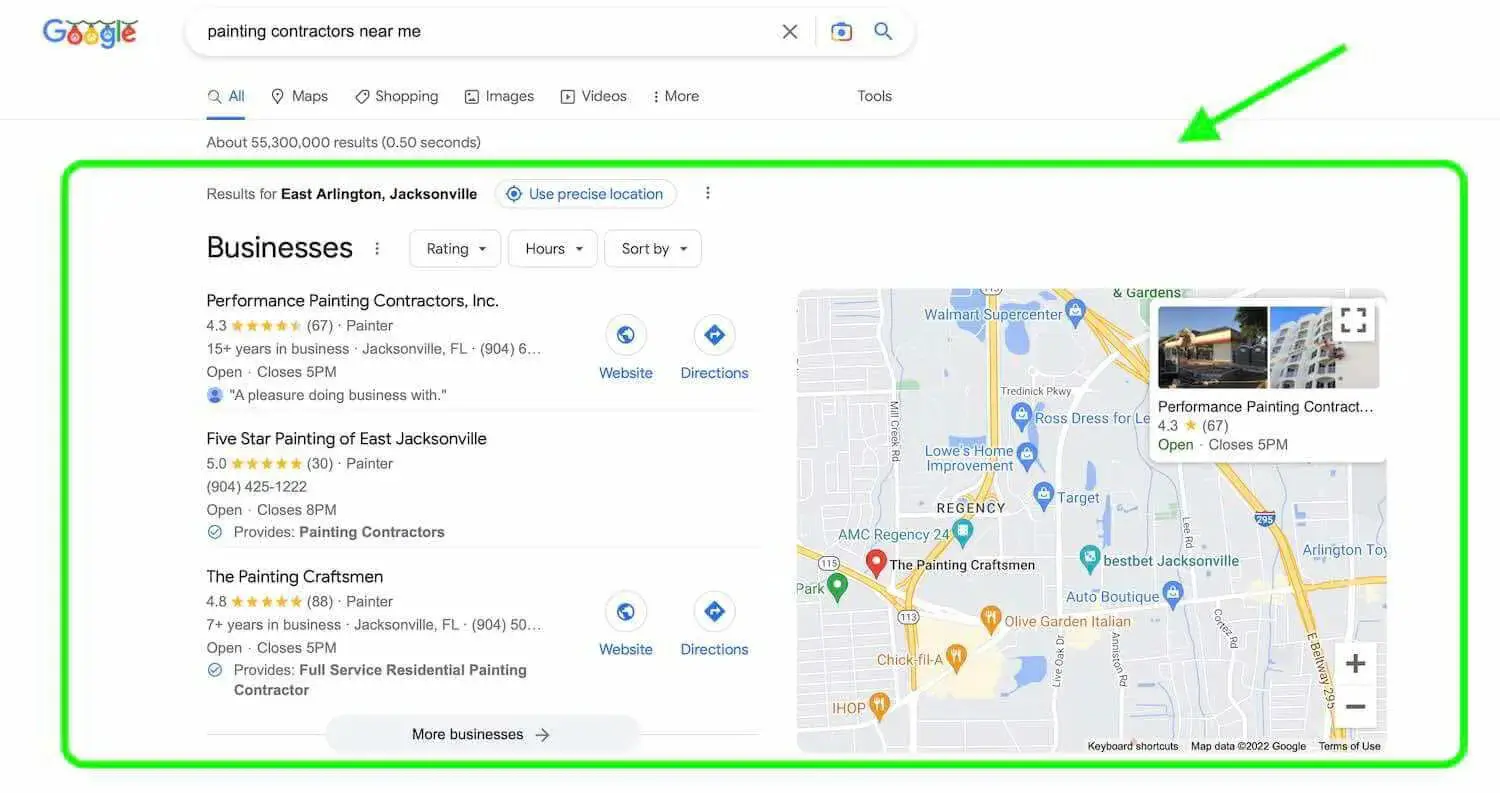
You don’t have to pay for local SEO, but optimizing your website requires more effort and time. The battlefield is continuously changing, so you must stay on top of trends and algorithms to ensure your business is ranking well!
#3 – SEO
Broader than local SEO, SEO helps optimize your website to increase organic SERP rankings. Tools like keyword research, content optimization, and link building are used in SEO to help improve rankings in organic SERPs.
On the one hand, traditional SEO focuses on your website’s visibility nationally or globally. On the other hand, local SEO captures local search territory, giving you access to a more targeted and localized market.
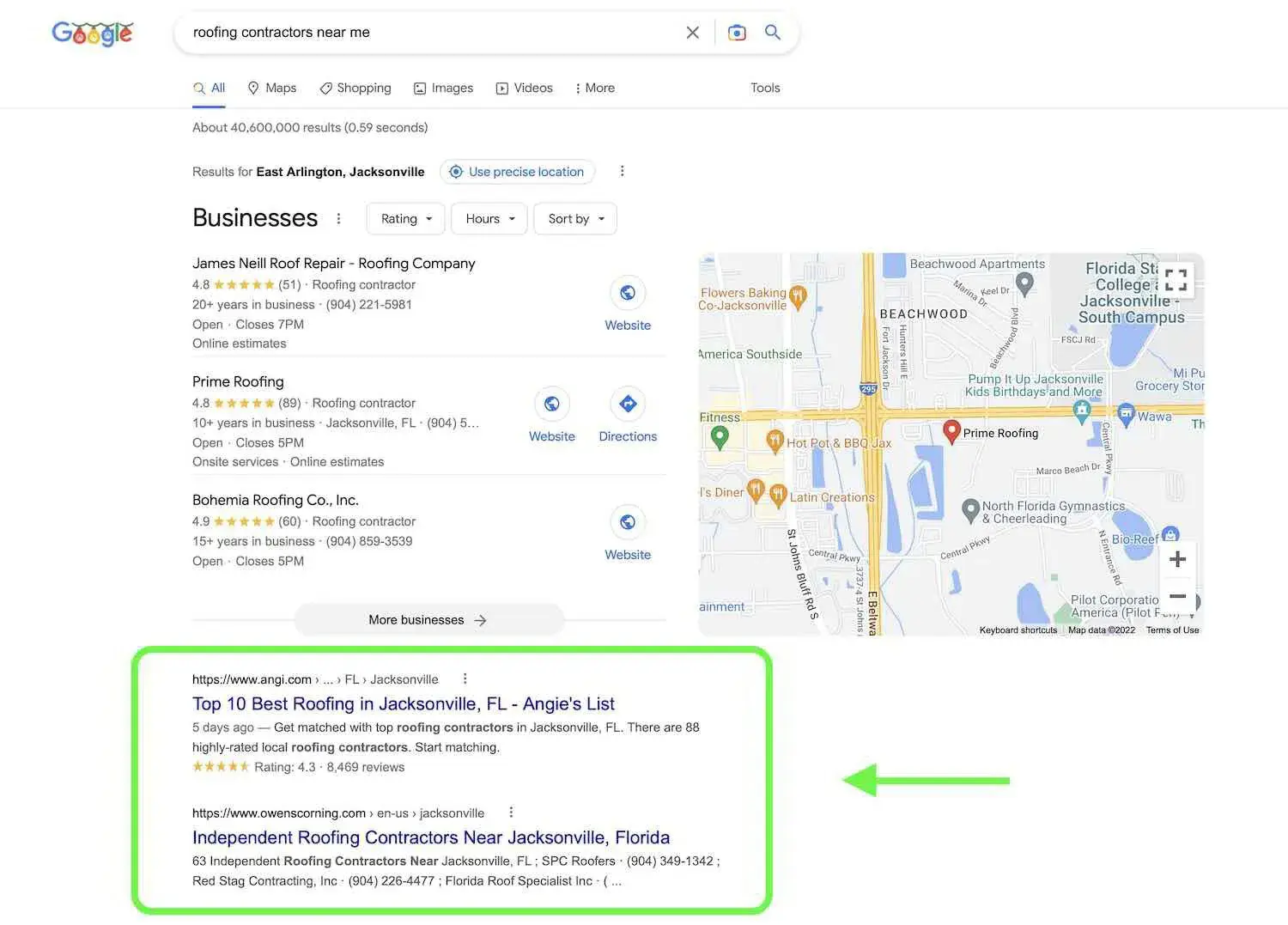
Remember: ranking for local searches and organic SERPs requires different strategies. Still, it would be best to use both to maximize visibility and reach.
Traditional SEO may increase your organic SERP ranking and help in the long run, but local SEO is the key to unlocking local search engines.
How to Rank Higher In Each Local SERP Feature
Ranking in every local SERP feature will be demanding. Businesses must invest time and resources to succeed; not every effort will guarantee results.
Nevertheless, working towards optimizing for each local SERP feature helps you and your business.
Here are some tips to help you rank:
Paid Ads
Tip #1: Optimize Your Quality Score for Paid Ads
Your ad rank is determined by the following:
- Bid Amount
- Auction-time ad quality
- Ad Rank thresholds
- Competitiveness of an auction
- Context of the user’s search
- The expected impact of assets and other ad formats
You have to focus on your Quality Score to increase your ad rank. Quality Score measures an ad’s relevance to a user’s search query and helps determine your position in SERPs.
Tip #2: Improve Your Ad Relevance
Optimizing your quality score means ensuring your ad is relevant to the user’s search query.
Ensure your keywords match what the searcher is looking for and that you’re providing relevant, helpful content.
Local SEO
Tip #1: Optimize Your Google Business Profile
Optimizing your Google Business Profile is the most critical factor in local SEO ranking!
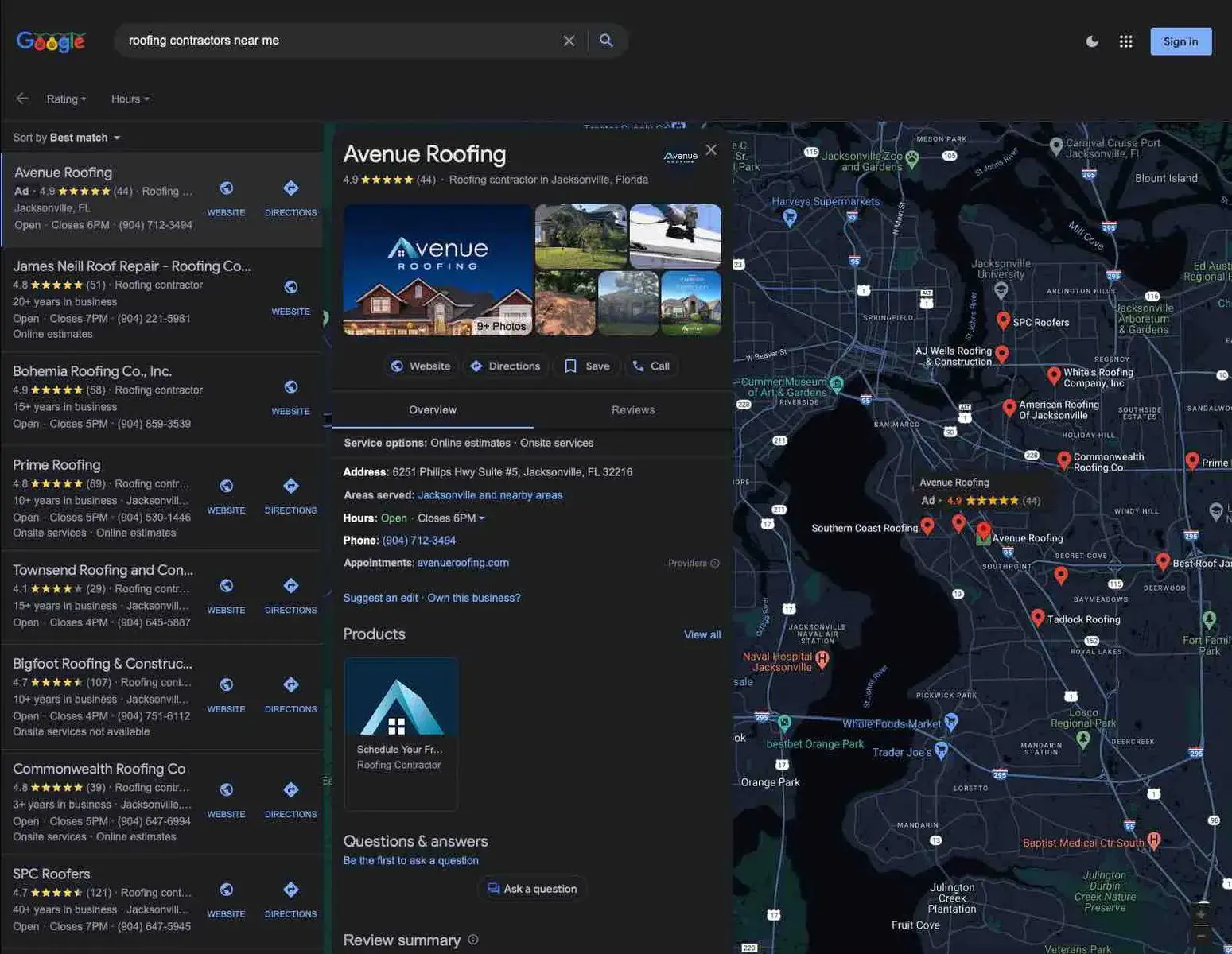
It’s a free listing that allows you to list all your business information, including name, address, phone number, hours of operation, reviews, and more.
It also helps you gain visibility on Google Maps and other local SERP features.
NOTE: If you don’t have a Google Business Profile, you need to add it or claim it, and after you do, make sure you fill it out completely.
Tip #2: Optimize Online Directories
Online local directories are a great way to get your business in front of more customers. Listing your business on online local directories will help your business gain more online visibility.
Remember to constantly update your business information, including your address, contact information, hours of operation, and website URL. You want your potential customers to find you easily.
SEO
Tip #1: Use Keywords Relevant to Your Business
Keywords play a huge role in local and traditional SEO. A keyword tool can help you come up with keyword ideas to use for your local SEO campaign.
Research keywords relevant to your business with a high search volume and that are less competitive. Once you’ve identified the right keywords for your campaign, you can use them in your content, ad copy, and website meta tags.
Tip #2: Improve Your Website
In addition to leading users to your website, you must ensure that it is attractive and easy to use.
Your website should contain helpful, relevant content related to your business so when users find you, they can quickly find the info they need.
Create content optimized for traditional and local SEO. Include a blog, FAQs, and case studies to help potential customers find the right answer.
It would also help to maximize social media opportunities to increase your visibility and reach a wider audience!
Tip #3: Hold SEO audits
Lastly, you must continuously monitor your website and track the performance of your campaigns. Hold regular SEO audits to identify issues, such as broken links, content gaps, and keyword cannibalization.
Fix any issues you find to ensure your website is optimized for local SERP features.
Remember, SEO isn’t a sprint; it’s a marathon.
Optimize for Local SERP Features With Search Click Grow
We know it can be a lot to take in, but with the right tools and strategies, you can rank higher in every local SERP feature. When you successfully optimize for local SERP features, you can watch your business grow!
Search Click Grow develops powerful online marketing solutions to help businesses see real and sustainable growth. We know just how vital local SERP features are in driving more customers to you.
If you want to learn more, check out our free webinar. We discuss what SERPs mean and offer strategy tips for ranking on the first page of Google results.

